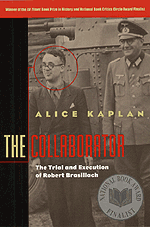Nominee for the 2000 National Book Critics Circle Award for General Nonfiction
Finalist for the 2000 National Book Award for Nonfiction
"The Collaborator is one of the best-written, most absorbing pieces of literary history in years."—David A. Bell, New York Times Book Review
"The James Dean of French fascism, as historian Alice Kaplan calls Robert Brasillach in her lucid and gripping new book, met a dismal fate that was shared by countless other collaborationists. But Brasillach's death was different [because he] was executed for intellectual rather than military or political crimes. The questions posed by Kaplan are still disturbing and poignant today, for Brasillach was essentially executed for what we would now call 'hate speech.'"—Lawrence Osborne, Salon
"In this rare scholarly page-turner, Kaplan employs the skills of a biographer and literary critic to flesh out the life of Robert Brasillach, a prolific and controversial French critic who was executed for treason, at age 35, after France's liberation from the Nazis…Everyone in the courtroom comes to life here…Kaplan…brilliantly demonstrates how a trial, and the lives of individuals, can serve as a metaphor for the entire nation."—Publishers Weekly, starred review
"The first scholar to have had access to dossiers in the case, she presents stunning portraits of the accused, the prosecutor, the court—whose members had themselves served the discredited collaborationist Vichy regime—members of the jury, and the defense. An important contribution to the voluminous literature on a dark period in French history."—Choice
"This gripping reconstruction of his trial—with portraits of judge and jurors and accounts of the defense and prosecution speeches—shows that Brasillach was perhaps unlucky to be executed; on the other hand, Kaplan is dismissive of any attempts to rehabilitate the reputation of what the prosecutor called a 'magnificent talent, which was useless because it wasn't merciful.'"—The New Yorker
"The riveting tale of an episode…that continues to affect French life and politics and raises profound moral issues…Kaplan focuses her resonant work on the enduring question of the responsibility of writers and intellectuals to their societies…An important contribution to French history."—Kirkus Reviews
The Collaborator
The Trial and Execution of Robert Brasillach
Alice Kaplan
Read an interview with the author.
![]()
January 19, 1945: Paris was liberated but the rest of France was still at war. The paradox is almost impossible to fathom: it was a time both of immense relief and anxious anticipation. The Germans were still holding various pockets along the Atlantic, as well as Colmar, in Alsace-Lorraine, the Eastern border region that had been passed back and forth between the French and Germans since 1870. Thirty-four days before the Brasillach trial, on December 16, 1944, Von Rundstedt's offensive nearly succeeded in recapturing Alsace-Lorraine for Germany and launching a new invasion whose goal would be to retake Paris. The liberated city wondered if its celebrations hadn't been premature.
The Germans, who'd kept more than an eagle eye on the Vichy justice system, had left the city during the bloody week of August. De Gaulle's provisional government now occupied the National Assembly, the city halls, and the courts. Vichy had disappeared.
The voice-over on the newsreel that played in the movie houses that week announced, "The cold continues its terrible offensive." It was the worst weather of the war, the canals and the Seine were frozen solid, the countryside "an immense icebox." The marketplace at Les Halles was empty and bakers had posted signs on their doors that read, "Bakery closed for lack of flour and lack of wood to fire the ovens." Because of paper shortages, the newspapers had reduced their formats to half-sized pages. An event like the arrival of concentrated milk made headlines.
"Existence in Paris is still abnormal with relief, with belief. The two together make for confusion," wrote New Yorker correspondent Janet Flanner in her "Letter from Paris": "Nourished by liberation, warmed by the country's return to active battle, France is still, physically, living largely on vegetables and mostly without heat."

Brasillach in court: January 19, 1945
Robert Brasillach's trial was scheduled to start at 1 P.M. on January 19, cutting the lunch hour short. A rationed hunk of cheese, thin soup, ersatz coffee—what else was there to eat in January 1945?
The jurors, Lucien Grisonnet, André Van der Beken, Emile Riou, and René Desvillettes, bolted down their meals, then made their long trek into Paris on the trains in from the suburbs, from Aubervilliers and Villetaneuse, due north, and from Champigny and St. Maur, due West, then to the metro.
They each got off at the stop called "Cité." The Ile de la Cité is a bottle-shaped island in the center of Paris that houses the reigning institutions of France's old and new regimes—the Préfecture de Police, the Hôtel Dieu hospital, the Notre Dame Cathedral, and the Sainte Chapelle, with its deep blue stained-glass windows, standing in the center courtyard of the massive Palais de Justice, which housed France's Kings before the Louvre. Walking solemnly through a massive iron gate topped in gold, the jurors were suddenly aware that they represented the people, the very conscience of the resistance. Inside the building, they proceeded down the wide marble hall known as "the room of lost steps," reminiscent of the corridor in a train station. It lead them to the Salle des Assises, the courtroom used for criminal cases. It was here that Robert Brasillach was going to be tried.
Brasillach himself took a long ride from his suburban prison. He was handcuffed and transferred from his cell at Fresnes to a prison van, which made its way in one straight line down the route d'Orléans, past the porte d'Orléans—the old gate of the city—continuing for a mile along the avenue d'Orléans, to the Luxembourg Gardens and the boulevard Saint-Michel. From there he was on familiar territory, passing through his beloved Latin Quarter until he reached the Seine. There was an entrance to the Palais along the quai de l'Horloge. Brasillach and his guard walked up a labyrinth of stairs and hallways, known as the "souricière"—the mousetrap—to a small room. There, he waited.
His defense lawyer, Jacques Isorni, left home earlier than usual, since he didn't want to take the bus to the Palais with Marcel Reboul, his neighbor and Brasillach's prosecutor.
Inside, the press corps was already bundled up against the cold cavernous space in their thick woolen jackets, known as canadiennes. With trials scheduled at a fierce pace morning and afternoon, day after day, the Palais had practically become a reporter's dorm. Specially accredited court reporters, who filed anonymous dispatches for the press agencies, had their own office in the building. Then there were the star reporters, with their recognizable by-lines, sent by the major papers to cover a specific trial. The press corps was preoccupied with the annoying paper shortages, which meant they'd have to limit severely the length of their stories on the trial.
The public entered the Palais de Justice in the same place as the jurors, through the big iron gates along the boulevard du Palais, facing away from the river bank. French law stipulates that trials are open to the public, and the Purge trials were enthusiastically attended—the great social theater of the Liberation era. In addition to a press box, there were seats for a hundred people in the back of the Salle des Assises, another twenty behind the prosecution, and there was standing room for twenty or thirty more. There wasn't a single empty seat that day. The crowd at Brasillach's trial looked like high society out for entertainment. The women were wearing gorgeous new hats, as though they were at a theater premiere. Wealthy people were there, free to leave their workplace or with no workplace at all. They had little in common with the working men of the jury.
Not that there weren't weighty thinkers in the courtroom. Representing postwar existentialist France were the philosopher Maurice Merleau-Ponty, two years ahead of Brasillach at the Ecole Normale, and Simone de Beauvoir. They were already in the planning stages of a magazine they would call Les Temps Modernes, to be directed by Jean-Paul Sartre. In the press box, to the left of the accused, were representatives of all the major resistance newspapers. Roger Grenier was away in the north of France, investigating the coal shortages that were making Paris suffer; wild-eyed Alexandre Astruc covered the trial for Camus's Combat. Women were well represented in the press: there was Madeleine Jacob for Franc-Tireur, whom Isorni had nicknamed "the hyena," and Francine Bonitzer for L'Aurore. Many of the journalists were in their twenties—the generation of Arlette Grebel and Roger Grenier—and were cutting their teeth on the Purge trials. The press corps was so changed by the Liberation that Edouard Helsey, for the conservative Figaro was practically alone among them in having been a colleague of Brasillach's in the 1930s, when he was still the precocious critic for the Action Française.
France has what is called an "inquisitory" system of justice. Its trials are divided into distinct acts, like the parts of a play. First there is the indictment, read out loud by a greffier, or court secretary, which is like a prologue. It sets out the facts that the rest of the play will confirm, or unravel.
Act I is the interrogation, where the president of the court questions the accused at length. Here, in the interrogation, the accused has a chance to express him or herself, in dialogue with the president—the presiding judge. Jurors, prosecutor, or defense may ask their own questions of the accused. Next, witnesses for the defense and for the prosecution are called: this is considered a part of the interrogation process. Judge, defense lawyer, and prosecutor may question the witnesses. Thus the interrogation, with its open dialogues, is tantamount to the cross-examination that takes place in an American court.
After the interrogation comes Act II, the prosecutor's speech against the accused, known as the "réquisition."
Act III is the speech by the defense lawyer, the plaidorie, or "pleading," for the accused.
With the exception of the interrogation, with its challenges both to the accused and to the witnesses, each participant in a French trial speaks in a controlled soliloquy.
At the end of the trial, after the defense lawyer's speech, the presiding judge asks the accused if he or she has anything to add. The right of the accused to a last word is a fundamental principle of French justice. The members of the jury then leave the courtroom for their deliberation. While an American jury is left alone, choosing a foreman amongst themselves, the French jury retreats into chambers along with the presiding judge, who assists them in their deliberations by explaining the punishment that goes along with each possible decision. The court comes back into session, and the verdict is read.
In the Brasillach trial, each act was to have a distinct mood, and vastly different dramatis personae. The stark theatricality of the proceedings was only heightened by the surprising absence of witnesses.
